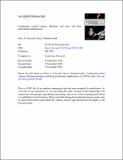Files in this item
Continental crustal volume, thickness and area, and their geodynamic implications
Item metadata
| dc.contributor.author | Cawood, Peter A. | |
| dc.contributor.author | Hawkesworth, Chris J. | |
| dc.date.accessioned | 2019-11-07T00:36:37Z | |
| dc.date.available | 2019-11-07T00:36:37Z | |
| dc.date.issued | 2018-11-07 | |
| dc.identifier | 256551927 | |
| dc.identifier | 2441f8fa-47e0-475a-b38b-f9bf0e136ab9 | |
| dc.identifier | 85056794939 | |
| dc.identifier | 000468246900007 | |
| dc.identifier.citation | Cawood , P A & Hawkesworth , C J 2018 , ' Continental crustal volume, thickness and area, and their geodynamic implications ' , Gondwana Research , vol. In press . https://doi.org/10.1016/j.gr.2018.11.001 | en |
| dc.identifier.issn | 1342-937X | |
| dc.identifier.other | RIS: urn:AADBB4B2C1811BC3F33D05AA3DD5258B | |
| dc.identifier.uri | https://hdl.handle.net/10023/18867 | |
| dc.description | We appreciate support from Australian Research Council grant FL160100168 and Leverhulme Trust grants RPG-2015-422 and EM-2017-047\4. | en |
| dc.description.abstract | Models of the volume of continental crust through Earth history vary significantly due to a range of assumptions and data sets; estimates for 3 Ga range from 120% of present day volume. We argue that continental area and thickness varied independently and increased at different rates and over different periods, in response to different tectonic processes, through Earth history. Crustal area increased steadily on a pre-plate tectonic Earth, prior to ca. 3 Ga. By 3 Ga the area of continental crust appears to have reached a dynamic equilibrium of around 40% of the Earth's surface, and this was maintained in the plate tectonic world throughout the last 3 billion years. New continental crust was relatively thin and mafic from ca. 4–3 Ga but started to increase substantially with the inferred onset of plate tectonics at ca. 3 Ga, which also led to the sustained development of Earth's bimodal hypsometry. Integration of thickness and area data suggests continental volume increased from 4.5 Ga to 1.8 Ga, and that it remained relatively constant through Earth's middle age (1.8–0.8 Ga). Since the Neoproterozoic, the estimated crustal thickness, and by implication the volume of the continental crust, appears to have decreased by as much as 15%. This decrease indicates that crust was destroyed more rapidly than it was generated. This is perhaps associated with the commencement of cold subduction, represented by low dT/dP metamorphic assemblages, resulting in higher rates of destruction of the continental crust through increased sediment subduction and subduction erosion. | |
| dc.format.extent | 6837846 | |
| dc.language.iso | eng | |
| dc.relation.ispartof | Gondwana Research | en |
| dc.subject | Continental crust | en |
| dc.subject | Plate tectonics | en |
| dc.subject | Continental area | en |
| dc.subject | Archean | en |
| dc.subject | Tectonic mode | en |
| dc.subject | QE Geology | en |
| dc.subject | GE Environmental Sciences | en |
| dc.subject | 3rd-DAS | en |
| dc.subject.lcc | QE | en |
| dc.subject.lcc | GE | en |
| dc.title | Continental crustal volume, thickness and area, and their geodynamic implications | en |
| dc.type | Journal article | en |
| dc.contributor.institution | University of St Andrews. School of Earth & Environmental Sciences | en |
| dc.identifier.doi | 10.1016/j.gr.2018.11.001 | |
| dc.description.status | Peer reviewed | en |
| dc.date.embargoedUntil | 2019-11-07 |
This item appears in the following Collection(s)
Items in the St Andrews Research Repository are protected by copyright, with all rights reserved, unless otherwise indicated.

